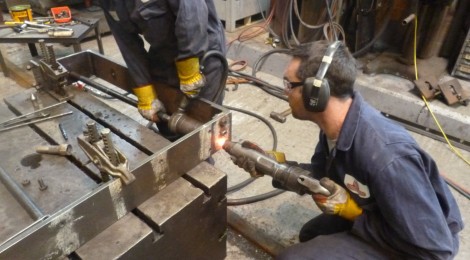
Samson exists – officially – frames are permanently assembled…
A steam locomotive’s identity is always allocated to its frames – all other components can be swapped, changed or replaced, but its identity and traceability follows the main structural members that support and form the spine of the locomotive. In Samson’s case, I haven’t felt it quite had an identity until the frames were permanently fixed together and yesterday, a long hot day in the boiler shop at Bridgnorth on the Severn Valley Railway, saw this permanence achieved and Samson, in my mind at least, officially become a locomotive and not just a set of parts awaiting assembly.
Duncan Ballard, who runs the shop, and Ross Cooper, his assistant, took on the job of riveting the frames using a mixture of countersunk and snap head rivets of 5/8 inch diameter. There were some 64 in total, and few were in a handy row to aid easy progress! The high temperatures and use of the oxy-propane torch to warm the rivets added further to the heat in the boiler shop but the job went well and was superbly carried out to give a result we are very pleased with.
In due course a short film of Samson’s progress to date will appear here, but in the meantime, here are some photographs grabbed during the day, an important one for this project as Samson became a real locomotive (works number BM2 – Beamish Museum 2 – BM1 is the Steam Mule).
Below: setting the scene and showing just how small Samson is when compared to a sizeable standard gauge boiler, in this case from 7802 ‘Bradley Manor’.
Below: A close up of one of the cold-formed 5/8 inch rivets used throughout.
Below: Sorry I haven’t rotated this one – limitations of Word Press – but it shows Ross reaming out the holes to take the expanded rivet (which by the very definition of heating it, becomes greater in diameter).
Below: Heating the rivets in a small furnace using oxy-propane to ensure an even heating. The rivets are heated until they glow yellow (orange is too cool) but before they become deformed by excessive heat or pick up slag from the furnace itself, the firebricks of which become molten by the heat from the torch.
Below: Ross has inserted the hot rivet and then places the jammer behind it, which uses an air piston to ‘jam’ itself between the frames and provide a solid resistance for Duncan to use the air hammer against, in this case to form the countersunk rivets which hold the boiler support and footplate brackets in place (located behind the bunkers).
Below: A close up of the jammer and the process of knocking over the heated rivet to form a flat head.
Below: Another view of the hammer and jammer with glowing rivet evident between.
Below: The finished result – the red paint marked the holes for riveting (as opposed to bolting). These heads were later ground flush.
Below: Moving on to the snap head rivets as Ross places the heated rivet into the reamed and cleaned hole. Note the rest of the bolts are left in place to aid accurate alignment, only being removed for reaming and riveting as required.
Below: The jammer is fitted with an angled adapter to enable it to fit into the awkward space between the front of the frames. Ross jams as Duncan hammers – the process takes only a few seconds to complete and a neat round rivet head on each side of the plates results.
Below: The frame extensions around the footplate were then tackled, using a mixture of jamming and clamping to ensure they didn’t move as the rivet heads were formed.
Below: The completed frames with the countersunk rivets being ground flush with the frames and polished to give a smooth and blemish free fixing. Much of the above will also be covered in the short film on Samson, which is being prepared.
Below: A close up view of Ross working on the grinding of the countersunk rivets. I then brought the frames home where they will be prepared for painting shortly. My thanks to Duncan and Ross for enduring the endless photo-taking during a long and hot day in the boilershop.
Below: Outside the shed, a respite from the extreme heat, Bullied Pacific ‘Sir Keith Park’ is seen warming through and looking very impressive in the mid afternoon heat – note that it is just the right amount of ‘dirty’!






















Recent Comments